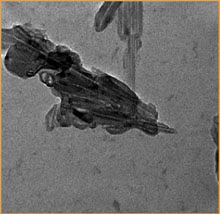Brent D. Johnson, Senior News Editor
Spiraling oil prices and electric power shortages have once again put alternative energy resources on the national agenda. As some politicians regard the Alaskan oil fields with longing, researchers are racing to develop clean-burning solutions for the country's energy needs.

Laser pulses vaporize graphite-metal composite materials to create carbon nanotubes that can hold hydrogen molecules for future fuel cell technology. Researchers are using an alexandrite laser to make more uniform nanotubes.
Jeff Alleman is a materials scientist at the National Renewable Energy Laboratory, which is developing hydrogen fuel cell systems for automobiles. The goal is to produce storage media that adsorb hydrogen at low pressure. That way, a car would not need to carry a high-pressure hydrogen cylinder.
Carbon nanotubes
Carbon nanotubes can keep hydrogen contained at low pressure and at much higher temperatures than either compressed gas tanks or cryogenic liquid storage. They are so narrow that hydrogen is the only molecule that can fit into the structure. This enables the chemisorption and physisorption of the molecule in a solid-state system.
Alleman is using a Pulse Stretched 101 PAL alexandrite laser from Light Age to create single-wall carbon nanotubes. He aims the laser beam at a graphite-metal composite material. The pulse vaporizes the material, which then condenses, forming the desired nanotubes. The lab had previously used a pulsed Nd:YAG laser for this application, but the device "was dying a slow death," he said.
Ideally, what he wanted for pulsed vapor deposition was a device whose pulse width could be controlled. The process produces carbon nanotubes of a variety of diameters. Researchers believe that if they can control the pulse width of the laser, they may be able to control the diameter of the tubes.
"The PAL 101 is the only laser that can do that," Alleman said. "The performance is very good. We are still working to vary pulse width."
However, the team doesn't know yet whether the variable-pulsed system improves the uniformity of the diameter of the nanotubes. "We have good results and bad results," Alleman said.